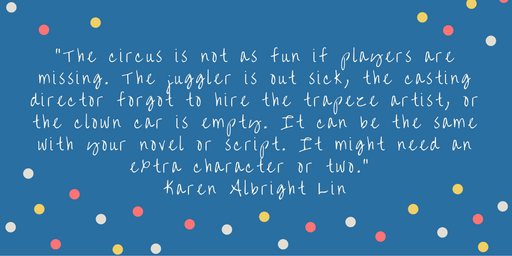Social media is a beautiful thing. It leads to friends nationwide, indeed the world over. I first connected with Karen Albright Lin in a literary discussion group on LinkedIn and quickly discovered her gifts as an author, editor, and pitch coach. Her presentations at writers conferences and on cruise ships (cool gig!) include editing from the top down and writing the nonfiction book proposal. She has ghostwritten novels and done work-for-hire writing for newspapers, magazines, and film directors. Learn more from Karen and her colleagues at Sisters of the Quill. Her editorial services address the development of fiction, nonfiction, narrative nonfiction, cookbooks, and screenplays. Today Karen shares her thoughts on the importance of secondary characters.
The circus is not as fun if players are missing. The juggler is out sick, the casting director forgot to hire the trapeze artist, or the clown car is empty. It can be the same with your novel or script. It might need an extra character or two. Even if you have a full complement of secondary characters, they may need to be made more robust or play a bigger role.
It’s usually not enough to simply add a character. That would be like adding one more dancer to a group of 26 background dancers. Make him or her count. Large casts of supporting characters demand deft handling, as exemplified by Charles Dickens and Victor Hugo, who created rounded secondary characters.
In Harold and Maude, secondary characters make this magnificent movie about death and love into a perfect one. In an early scene, Harold’s blind date beats him at his own staging-suicide game by simulating hari-kari in his living room. It surprises us and mocks his mother’s matchmaking.
It hurts, but sometimes you need to excise one of your characters. On the one hand, meld two characters into one role. On the other hand, you may add one whose job is to create an additional obstacle. The fairytale “Cinderella” could unfold without one of the stepsisters; however, combined with the wicked stepmother, they become a seemingly insurmountable force. Three is often a magic number. If you have two people, consider collapsing them into one for a stronger character or adding another to make a happy triangle.
You could use a secondary character as an audience surrogate like Stingo in Sophie’s Choice. He observes and comments on Sophie’s life, current and past. John Wheelwright relates a current story as well as Owen’s story in A Prayer for Owen Meany.
Add a character that is much older or much younger to offer another perspective. In The Blind Side, Sandra Bullock’s enthusiastic young son only has one essential scene, yet he adds a layer of sweetness that enhances a tender and profound story.
Ben Stiller’s future mother-in-law in Meet the Parents plays the quiet role of foil to her overbearing husband. Technically, she could disappear from the plot, but it’s nice to see someone rooting for poor Ben. Take the lead from this movie and throw in an animal to add zing. Perhaps give it a prominent role. Painting a cat’s tail—exposure of the subterfuge—sparks the climactic showdown between Ben Stiller and antagonist Robert De Niro.
A historical or imaginary character may come forward in time. The League of Extraordinary Gentlemen, in which we find Dorian Gray, The Hulk, Dr. Jekyll, and others, is an extreme case of this modus operandi. Many time-travel romances use the technique. Reversing that approach, The Magic Tree House series and A Connecticut Yankee in King Arthur’s Court take us back in time to meet secondary characters.
If you write fantasy, consider giving an aunt an unexpected magical power. Add an impersonator, a character in disguise, or characters who trade places. A mentor (e.g., the fairy godmother, Gandalf, Mr. Miyagi) comes in handy, as does a rival who is key to the resolution (e.g., Harry Potter’s Lupin Werewolf and Pettigrew Rat).
An ancillary character is not always a mentor, sidekick, or foil. She can be a plot plant. Mysteries often add villains who seem to have something to do with the crime but don’t. Red herrings are the stuff of great suspense—the more, the merrier.
These represent only a few ways you can add, subtract, enhance, or fashion another purpose for a secondary character. Be sure to provide a sense of who they are in relation to main characters, even if they don’t get much stage time. Create them as carefully as your protagonist and antagonist—and you’ll richly layer your work.
Shakespeare, the master of sexual confusion, exploits love triangles, disguise, and trickery in Twelfth Night. Viola, disguised as the boy Cesario, falls for Orsino, who courts Oliva, who adores Cesario. Olivia mistakes Sebastian, Viola’s twin, for Cesario and declares her love. Household steward Malvolio, who has the hots for Olivia, disguises himself as a nobleman in crossed garters and yellow stockings to woo her. Maria, Olivia’s gentlewoman, tricks Malvolio by forging a letter that declares her mistress’s love. As Malvolio’s station falls, hers rises when she hooks up with Sir Toby Belch, Olivia’s kinsman, who revels in the hilarity of this bedlam. Feste, Olivia’s fool garbed as Sir Topas, plots a future as a nobleman and talks to Malvolio after he’s falsely pronounced mad and locked in a darkened room by Sir Toby and Maria.
Got that?
For the rest of the story, head to the nearest Shakespeare festival.








Leave a Reply